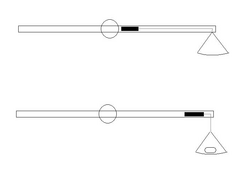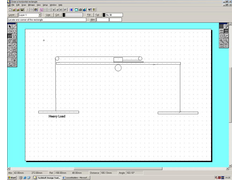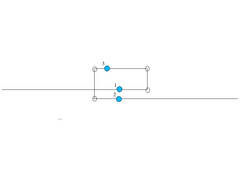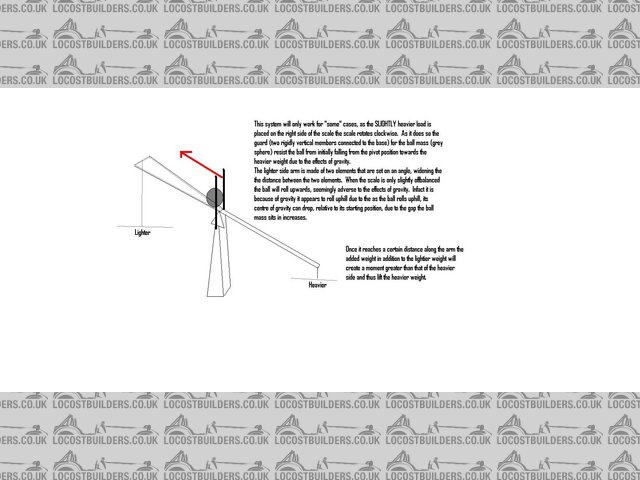
Engineering genius required!
Mike R-F - 1/2/06 at 12:20 AM
I realise this is completely off topic but I need some help in creating something that may be impossible, but, hey, that's never stopped anyone
on this site before!
As part of an ongoing project, I need to produce a giant set of 'working the wrong way round' scales. In other words, scales that go down on
the lightest side and up on the heavier side. Something a bit like the balance in Justice's hand on top of the Old Bailey. The height of this
would be about 1.5-2M high at the point of pivot & about 4M across the balance arm. The mechanics for making the scales work in reverse can be
hidden within the central pivot section.
This problem has been driving me up the wall for some time now because I think it
should be possible, I just don't know how!
If anyone comes up with an idea that works, you'll get my vote for engineer of the year!
Mike
k33ts - 1/2/06 at 12:32 AM
surely the only way is moving the pivot point then that would only work depending on the weight difference
Liam - 1/2/06 at 12:50 AM
Trouble is you want to lift a heavy object with a light object without any mechanical advantage (leverage). You have to put energy into the system
somehow to achieve this. I can't see how it can work without some kind of power source therefore.
You could do it without power by having the pivot very close to the heavy object and very far from the light object, but it wouldn't really look
like scales and would only work one way round.
Liam
iank - 1/2/06 at 01:16 AM
What you need there is an anti-gravity machine. Where do I claim my prize. 

If you actually want it to work like scales i.e. look like scales and move 'realistically' i.e. exactly the same as real scales but upside
down, you will need to actively power the thing. The control system will also need to know which is heaver (and by how much if you want to control
the speed for realism purposes).
Measuring the weight should be possible with strain gauges on the arms, and getting the movement could be electric, hydraulic or pneumatic depending
on what kind of weight you want to move around (from the size of the thing you could get some big stuff on there), and how you want it to
look/sound/cost etc etc.
The control system is the key to it's realism, and might not be trivial to get right.
Oh and if people are going to be putting stuff on with their hands you might want to consider safety - it's a big chunk of metal/wood to have
swinging around close to heads. Especially as it's designed to be completely counter-intuitive 
stevebubs - 1/2/06 at 01:31 AM
Everything is relative... stand on your head...
I'll get my coat....
stevebubs - 1/2/06 at 01:35 AM
More seriously, and given that an anti-grav machine is against us so it must be powered, how about...
Fit a set of scales under the pad you're placing objects into. This will give you the mass of the object placed. Feed this input into a control
system
Drive the whole assembly on a giant stepper motor or whatever so all up/down movement is controlled electronically based upon the mass input...
stevebubs - 1/2/06 at 01:36 AM
BTW If you need to measure the difference between the two sides, you'll obviously need a set of scales / pressure pads etc on both sides...
iank - 1/2/06 at 01:58 AM
quote:
Originally posted by stevebubs
...
Drive the whole assembly on a giant stepper motor or whatever so all up/down movement is controlled electronically based upon the mass input...
A stepper motor that could move a 4 meter beam would be an impressive beast indeed 
Mix - 1/2/06 at 07:28 AM
Hydraulics are one solution 
The weight acting on the pivot bar would operate a pilot valve to control a servo piston which would move the beam, with a bit more thought I could
probably come up with a system to make the movement proportional to the load.
Mick
Mike R-F - 1/2/06 at 07:59 AM
Thanks for all the input, even the anti-grav suggestion! I should have mentioned that the site this device is going onto has no power so the mechanism
has to be purly mechanical. The suggestion of using hydraulics appeals. Any mileage in this?
A simple way of achieving the desired result would be to have one half of the balance arm constructed out of a heavier material than the other &
'locking off' the scales in equilibrium. Then, once a 'heavy' & 'light' object had been placed on the scales, a pin
could be removed allowing the balance to work in the opposite way to convention. But I still feel sure that inter-connected pistons or springs would
create the same effect without the need to lock the balance arm off or resort to such a crude solution.
Keep them comming, please!
Mike R-F - 1/2/06 at 08:09 AM
Mick, you have U2U.
caber - 1/2/06 at 08:10 AM
What you have is probably the best suggestion however I am not sure how the scales will reset themselves with no load or input from the user. Before
you said no power I was thinking about adapting a power steering rack to provide force. There has to be some power input somewhere, any number of
pulleys and levers will absorb energy by frictionand you still need to work out the amount of force you will be applying to determine the multiplying
factor between light and heavy sides.
Caber
cossey - 1/2/06 at 08:31 AM
a way round it would be to have a normal set of scales made of aluminium but with iron/steel pans. then place the whole scale setup on a pedestal and
put electromagnets in that then with the items removed and the magnets off they arm will balance straight but turn on the magnets as you place the
items and you can raise the heavy side and drop the lightside.
Mike R-F - 1/2/06 at 08:52 AM
Caber, re-setting the scales is not a problem. This is intended for an educational facility where groups of school children will be guided round &
a numer of the activities will be 'set up' by the guide prior to the tour. All we are trying to achieve is a little bit of 'magic'
where things don't work the way kids would expect them to.
Electromagnets wold be great if I had the means to power them which, unfortunatly, I don't.
Thanks again for all the suggestions, please keep them comming.
Mike
cossey - 1/2/06 at 08:57 AM
if it is completely power free then it is impossible. however if you mean you cant use electricity then you are going to have to use springs or
pneumatics with a small cylinder of compressed gas hidden somewhere.
nick205 - 1/2/06 at 09:02 AM
Can we ask what you need to do this for? 
DaveFJ - 1/2/06 at 09:04 AM
how about making the arm to the smal weight hollow and having a weight inside that can move. maybe you could connect it to the pan so that a small
object would move the weigth along the arm... something like this....


Description
skint scotsman - 1/2/06 at 09:19 AM
as its for school kids couldn't you just make one side of the scales heavier than the other but look the same lock them of at the
'balance' point then make abit of a show and release the mechanism.
you would have to get your sums right so as there was no way the little blighters could upset the balance by overloading the supposed heavy side.
just my 2 euros worth hope it makes sense
DarrenW - 1/2/06 at 09:39 AM
Why not make the scales in a conventional manner but play about with the weights.
Make the smaller weight out of lead and Paint on the front 10Kg
Make the larger weight out of something hollow, fill it with sand so it is just lighter than the smaller one and paint on the front 20Kg.
Net effect is the larger and assumed heavier weight will move up whereas the smaller and assumed lighter weight will go down.
Iam making the assumption here that the scales are huge, kids are not and you wont be allowing anyone to touch or feel the weights first.
You could also have a small set in front for the kids to play with that work normally.
[Edited on 1/2/06 by DarrenW]
jos - 1/2/06 at 11:41 AM
I just had a thought, coul dyou use a gyroscope to create an opposite force. I remember being sat on a chair (at school) with castors holding the
axle of a spinning bicycle wheel and making myself turn by using opposing lean angles on the axle.
Just a thought, but probably not possible due to lack of power for rotating or powering the gryo
MikeRJ - 1/2/06 at 12:23 PM
If the heavy weight has to move up as much as the light weight moves down, then without resorting to trickery and illusions this is physicaly
impossible to achieve. If you do manage this, then congratulations, you have the beginnings of a perpetual energy machine 
Pre-loading the scales with hidden weights and being carefull never to show the balanced "unloaded" is probably the easiest method.
Mike R-F - 1/2/06 at 12:45 PM
Hi all, thanks for so much input on this. I like DaveFJs idea of a concealed moveable weight.
In answer to the questions about the purpose of this, I should perhaps explain a little. The scales form part of an outdoor educational facility being
built by a local authority to motivate schoolchildren to think more positivly about the environment and, in particular, the way we dispose of waste.
Without getting into the graphic message, the scales are intended to form part of an area about 'Restoring the Balance' in which children
would look into the problems of landfill/incineration/recycling, hence the scales. E.g., one bag full of plastic milk bottles (light) put into
landfill is worse for the environment than a months worth of organic waste (heavy) put into composting, which is good. I appreciate that you can argue
that this would work with the scales in a conventional manner but the way in which the message is put across works best with the scales in reverse.
The scales would be operated by the guide, not the children, so use of hidden weights/levers could work well.
Hope this helps!
Spyderman - 1/2/06 at 01:39 PM
One way I can see it working would involve mirrors.
If the scales were in a cabinet behind a selection of mirrors then you could make left seem right and right seem left. As long as both weights looked
similar in shape and size then the audience would not know they were seeing the opposite side.
Again using mirrors the scales could be built upside down, but would look right way up from front then the different size and weights would appear to
go against gravity. Both weights would need to be magnetic to stick to upside down pan.
Another method would be to use magnets. With a powerful magnet under one side of the scales (or both) it would affect which way the scales tipped,
dependent on which way the poles of the magnetic weights were placed onto scales.
Probably not very clear, but I know what I mean! 
jambojeef - 1/2/06 at 02:31 PM
How about this?
Its based on Dave's idea but the balance should go the other way when the weight is placed on the scales...
If the balance of weights is correct and stuff.....?
Geoff


Rescued attachment balance.JPG
cossey - 1/2/06 at 03:32 PM
that would work if you had a spring going from the left of the weight to the arm that way the weight will only move by the right amount if carefully
setup.
davidcarr - 1/2/06 at 05:15 PM
With that setup the heavy weight would still drop. 
It really depends on what you want the behaviour to be.
To get it to act like the small mass was in fact larger, so that when you put both on it would drop towards the smaller mass, you could either:
Increase the moment of the small mass around the piviot. The simple way is to increase the distance from the pivot point - but this has been
suggested.
Reduce or counteract the moment of the large mass around the pivot. This involves reducing the distance of the large mass from the pivot, or
counteracting it, perhaps with a spring above the scales on the heavier side or below the scales on the lighter side? A nice strong spring near the
pivot on the light side (below it) would do this nicely.
If however, as you say, you'd like the scales to go up when the large mass was added, you need to get some energy into the system without the
kids seeing.
What about a hollow bar acting as the lever with a heavy ball bearing in it. If you sloped (ever so slightly) the inside of the bar down towards the
light side you could prime it with the ball bearing at the top of the incline(heavy side) and have a release mechanism triggered by the addition of
the larger mass (just like a mouse trap). The ball rolls to the light side, adding weight, et voila. With the addition of a spring to countact some
of the moment of the heavy weight, the bearing wouldn't have to be all that heavy.
[Edited on 1/2/06 by davidcarr]
davidcarr - 1/2/06 at 05:31 PM
Its also about how you carry out the experiment.
The system is always going to tilt towards the first mass you put on - unless you use the ball bearing thing.
Say you only had one mass. Put it on, ball bearing releases, scales go up, kids go wow.
It wouldn't work so well with 2 masses since as you've got to put one on first, the scale will already be heavily tilted to one side (light
side), when you put the second on, it won't be able to go any further and so won't be amazing even if it does want to go 'down'
further on that side.
With 3 masses, 2 the same, you could put one on each side (after agreeing that they were each the same mass with the kids). Then you could put
another on the heavy side, trigger the mechanism and the light side will go down. Kids go wow.
Sorry, just a stream of consciousness.
And excuse my use of small mass/light weight. I know mass(Kg) * 9.8=weight(N) on Earth, its just easier to use light than small.
DarrenW - 1/2/06 at 05:47 PM
As i said before id say easiest way would be to use dummy weights that gave the illusion that one is heavier than the other.
I assume that being a demo rig of huge proportions the kids wont actually get to touch it.
chriscook - 1/2/06 at 06:55 PM
Does this work? Blue circles are pivot points and open circles are joints between levers. All levers are say 10:1 ratio. 1kg on one side should
balance 10kg on the other side. The bottom 2 pivots could be coaxial - not sure if the balance arm would appear to bend when not balanced though and i
can't be bothered to do the trig!
Chris


Rescued attachment scales.jpg
MikeRJ - 2/2/06 at 11:25 AM
That would sort of work, but the heavy mass would be raised a 1/10th of the distance that the light mass falls, so it would indeed "bend" in
the middle quite significantly.
fastenuff - 2/2/06 at 09:23 PM
I asume the scales are ment to look symetrical left and right same length (Arm)
For a solution you need to set a procedure written down, as i a manual.
With tricking audience you have to make sure it is done well. If you make sure a guide/teacher operates the devise they have to be clued in on how it
works.
If the public is to operate the machine you have you have to limet the choices they can make, as in left is organic/ less harmful than the right side.
use incompatible hooks to load bad and good side.
one way of going about it is to load, the more harmful side first so a counterweight can be released or locked.
another is by making the containers of differend weihgts.
neither are good when the gen. public are to use the scales
fosko - 3/2/06 at 06:39 PM
All a bit confusing to me but a fiend of mine came up with this. he says the idea is flawed and can be improved on, but should work. Hope the pic
works not posted pics up on here before.


Rescued attachment untitled.JPG







